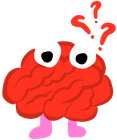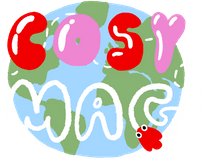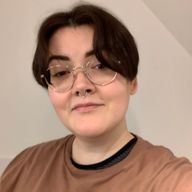The first time I ever heard the word asexual, I was 23 years old.
The topic came up concerning a friend of theirs who was in the theater program, who had apparently said she was “gray-ace.”
“What’s that?” I asked, curious.
“Oh, that’s like - it’s like not wanting sex,” one of the young men said to me.
“Yeah, it’s like not having sexual attraction, except some of the time. Like, rarely.”
“Oh,” I nodded, thoughtful, not truly understanding, “huh.”
I put the idea of that away in the back of my head. Later when I saw her, I asked her several questions about asexuality and what gray-ace meant. I was interested in understanding her, but I also was interested in how much of what she said rang true for me. Where had this thing I’d never heard of been all my life? What did it mean?
Three years later, after talking to a lot of aces closely and asking myself some very hard questions, I came out as demisexual on Instagram, and in June of 2020 I began to write about it.
Even before I had begun to make full sense of these words, what they meant, and the different things housed under them it made sense to me that they were queer, a part of the alphabet mafia, the A in LGBTQIA+. There are many people - both queer and not - that think that asexualiy and aromanticism don’t exist, or that if these do exist, that they are not the reason for the A in the acronym. This has become such a point of discussion that I have decided to take the time to break down why yes, aces and aros have every right to call themselves queer.
Here, we will break it down and explain why the A in the alphabet isn’t for ally - it’s for asexual, aromantic, and sometimes agender.
First and foremost, there is sexual attraction and romantic attraction.
Sexual attraction, you want to have sex with that person. Romantic attraction, you want to date and romance that person.
Gender, both your own and theirs, may or may not matter. It should be straightforward (no pun intended) but there are actually a lot of gray areas under the spectrums of asexuality and aromanticism. Even for people who don’t exist in a gray area under one or both of these, there may be actions that don’t seem on the surface to line up with one’s aforementioned orientation. For example, aces might or might not have and enjoy sex. Similarly aros might or might not have and enjoy romantic relationships. All of these people are the orientation they say there are, but the why and how of it can be like trying to explain to someone a color that you know you can’t see.
Consider that we are taught our entire lives that everyone has sexual attraction, that sometimes this attraction is considered “wrong” or “deviant” but it is still there, and romantic attraction usually follows suit for most people.
These experiences and definitions for asexual and aromantic spectrum identities matter immensely because they let us know that there are other people who experience the world romantically and/or sexually the way that we do. It helps to show us what colors other people see and tell us what colors we don’t.
There are expectations of performances of sexual and romantic activity, inside and outside of heteronormativity. These are called allonormativity and amanormativity.
Allonormativity is the expectation that everyone is allosexual, meaning they are not asexual or somewhere in the gray area between being ace and allosexual. In other words, everyone experiences sexual attraction and, that the sexual attraction they experience is not rare, nor does it have to be met under specific circumstances to occur. This is again why graysexuality and demisexuality are housed under the asexual umbrella - while demisexuals and gray aces might experience sexual attraction, they speak to exceptions to what is a largely asexual life.
Allos may be of any sexual or romantic orientation or any gender. The thing that makes someone allosexual is that they are not ace - that’s it.
Amanormativity is the expectation that everyone experiences romantic attraction, or that everyone is alloromantic. If someone is alloromantic, they are not aromantic, or somewhere under the aromantic spectrum. Alloromantics may be of any sexual or romantic orientation, and any gender. Asexuality and aromanticism, while there is some overlap in the communities and some people are both ace and aro, are not the same thing.
Allonormativity and amanormativity both play a significant role in heteronormativity, or the expectation of people to be allocishet - allosexual, alloromantic, cisgender, and all romantic and sexual attraction directed towards that of the opposite gender - which in the case of heteronormativity, is also defined as towards the opposite sex, as opposed to gender existing as a spectrum.
Heteronormativity houses the expectations of allonormativity and amanormativity, as well as the expectation to be cisgender (identify with the gender one is born with, not transgender or nonbinary). In spite of the forward momentum of queer rights and recognition, heteronormativity is still everywhere in western culture.
People of all queer orientations and genders have to deal with heteronormativity at some point, whether they experience sexual and romantic attractions or not. This includes aspecs. After all, if we aren’t experiencing sexual or romantic attraction, or we’re experiencing it rarely, and are being told that we need to reproduce and get married by the entire world, then of course we’re also experiencing harm from heteronormativity.
A person must be allosexual, alloromantic, cisgender, heteroromantic, and heterosexual in order to be straight, this should give everyone who is aspec room to breathe and feel free to be ourselves in the queer community.
Given that a person must be allosexual, alloromantic, cisgender, heteroromantic, and heterosexual in order to be straight, this should give everyone who is aspec room to breathe and feel free to be ourselves in the queer community.
A person should need to not match just one of these groups in order to be queer.
An asexual heteroromantic cisgender person is not heterosexual. An aromantic heterosexual cisgender person is not heteroromantic. This also does not account for the different types of attraction that both aspecs and allos experience, such as (but not limited to) emotional, sensual, aesthetic, and platonic.
It is important to note that we are not the only people who separate these types of attraction; aces and aros are more likely to label them. Allosexuals may experience aesthetic attraction without much thought, which may or may not accompany sexual attraction. Alloromantics may experience platonic attraction without much thought to its specifics. Aces and aros are more likely to label these types of attraction because it can explain the experience of one type in the absence of another that we have been taught should go together.
Aspecs are not the only people who define our attraction by who we are and are not attracted to and by how much - yet aspecs are the ones who get the most flack for doing so. Why is this? After all, if most of the queer community can recognize that a person needs to be cisgender, heterosexual, and heteroromantic in order to be completely straight and not a member of the queer community, then surely these same people can recognize upon learning about asexual and aromantic orientations that these separations matter to us and do in fact ensure our position within the queer community.
Instead, aspecs are often told we don’t belong here.
In the worse case scenarios, we’ll be asked about our orientations and then immediately told we don’t exist.
It’s especially hard when so many members of the queer community don’t want to call you, a queer person, queer because you’re not doing it like they are.
But we are queer.
It’s especially hard when so many members of the queer community don’t want to call you, a queer person, queer because you’re not doing it like they are.
Aspecs experience harm at the hands of heteronormativity, just like all queer people. Being ace or aro does not exempt us from the expectations of a heteronormative world, nor from the allonormative and amanormative expectations from the queer community.
This means many things for aspecs.
It means we are expected to have a sex drive towards our partner and being questioned by doctors if we admit we do not have this, as if it is an illness to be cured.
It means when we find ways to have relationships with different types of intimacy and different names of attraction and different words that are still very close, but neither sexual nor romantic, we are on alert for judgment from both the non-queer and the queer community.
It means psychiatrists telling us that we may need to be taken off of a medication that could be life-saving if it’s believed that it’s taking away our libido, as if that’s all asexuality is.
It means being afraid of someone trying violently to correct us, even if we are sex and/or romance favorable.
It means denying an essential part of our personhood for years, even decades, because we were told that these experiences didn’t exist.
It means never knowing who in the queer community is going to accept us.
It means being told that if we are in a relationship that looks ‘straight,' we don’t belong.
It means wondering why our queer siblings never told us that this was a part of the community - and then finding out that many of the people you had thought would surely support you, who you thought would surely understand the struggle of lesser-known sexualities and romantic orientations, don’t consider you to be a part of their group.
It often means feeling invisible, even within the invisible.
While the hardship of aces and aros is often dismissed by queer and non-queer people alike, it must be stated that queerness is not defined by suffering. It is defined by queerness.
So often what’s happening in gatekeeping is a mixture of people ignoring the experiences of those they don’t deem “worthy,” and a sort of “oppression Olympics” - as if that’s what makes a person queer, rather than their sexual orientation, romantic orientation, and/or gender identity.
What aspecs go through both at the hands of heteronormativity and at the hands of exclusionists and gatekeepers within the queer community is very real and very painful, and it should not be ignored. It is exhausting to be made invisible in a community that prides itself on making queerness visible because of experiencing it differently. While queerness is not defined by suffering, it is a common experience for many aspec individuals. When this erasure comes from other queer persons, it is especially painful.
Defining queerness by suffering is saying that if you did not live a life of the ‘right’ kind of suffering, you cannot be queer. Whatever is the ‘right’ kind of suffering is also something that changes from gatekeeper to gatekeeper, a fencepost that is always in flux, with qualifiers always out of reach by those who think they are in charge of the post.
Prioritizing suffering also teaches us to ignore the good parts of our lives when they do happen. It says to the future generations of queer people who I hope can look back on us with thankfulness that they do not belong in the queer community because they didn’t have to fight as we are fighting now. We say this is what we are fighting for, and simultaneously dismiss those harmed by that fight if they haven’t been through “enough” - as if queerness were measured by suffering and suffering alone.
As Bojack Horseman once aptly summarized, “...when we valorize the idea of sacrifice - of loss, of suffering… When we grow up in a house that does that, we internalize this idea that being happy is a selfish act, but sacrifice doesn’t mean anything.”
Coincidentally, Bojack Horseman was one of the first popular shows to have a canonically asexual character, Todd Chavez.
This doesn’t just happen to us, either; much of aphobia (prejudice towards asexuals, aromantics, and orientations housed under these umbrellas) reflects discrimination towards bisexuals. Both groups face discrimination for the expected performance of their orientation and are scoffed at when they rightly point out that “passing privilege” is actually queer erasure. “Your homophobia doesn’t look like my homophobia, so you don’t belong here.”
The current climate towards aspecs is one often comprised of confusion, dismissal, and at times outright hostility. While we do have queer allies, more often than not we must call on each other in order to find solace and understanding. Our problems are often ignored in favor of instead facing us with prejudice, and when we are brave enough to stand up and state out loud what our hardships have been — which can include sexual assault, chemical correction at the hands of medicine, dismissal from our families, and many other violent things we face specifically for our orientations — we are gaslit by the very people who are supposed to want to accept us, as we are, in fact, queer.
With this piece, I hope to sway some minds who may think that we are not. Whether or not we have not suffered for our orientation, this does not mean we are not queer as again, queerness is not defined by suffering — especially if the suffering presented is ignored by the people who claimed they wanted to know.
Asexuality and aromanticism defy heternormativity by their very nature, and even allo and amanormativity within the queer community as well. Asexuality and aromanticism challenge traditional relationship structures, expectations towards sexual behavior, action, and attraction, much in the same way that other queer people do.
So much of this piece has been about the suffering of the aspec community, as I did not feel I could leave it out of the overall discussion when it is so often turned against us. I do not want to leave out the joy and the good, too, though. There are good and bad things about living an aspec life in an allo world. The good can be made better by more understanding, education, and acceptance.
It should also be noted that aces and aros are not missing out because of not experiencing sexual and/or romantic attraction.
We are not distressed by our sexuality or romantic orientations. We can lead happy, fulfilling, rich lives all on our own, or with partners. We laugh. We have close, intimate friendships. We love. We have hobbies, pets, boyfriends, girlfriends, and partnerships, queerplatonic or otherwise. We experience grief, loss, and pain — but we also experience joy, laughter, and comfort from our loved ones. The fear of being aspec comes not from inside of us, but instead from a world that is willing to inflict harm on us because of not needing in the same way they did.
I get a lot of hateful messages and abusive comments, but I also get a lot of questions from people who don’t know if they’re aspec, who are just looking for someone to be patient enough to try to help them find some answers to questions they didn’t realize they had but can’t get off their minds. The question I get asked most — more than anything else, more than about definitions, even more than “do you think I’m ace/aro” — is “am I queer?”
The question I get asked most — more than anything else, more than about definitions, even more than “do you think I’m ace/aro” — is “am I queer?”
I always tell them, with confidence, the answer is yes. I hope that with time and the increase in the spread of information about aspec orientations, more and more people will say yes, too.
Asexuals, aromantics, and orientations under these umbrellas — demisexual, demiromantic, graysexual, grayromantic, and many more — are queer. We are here, right alongside you, just asking for your acknowledgement.
I hope you will say yes.















